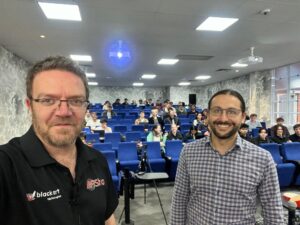Last Tuesday (June 3, 2025), our CTO, David de Haaij, returned to the University of Adelaide to deliver his 13th annual guest lecture. Over an hour and a half, he shared a deeply personal and highly practical look at the world of RF engineering, covering everything from early career lessons to cutting-edge technologies shaping the future.
This was more than a lecture. It was a masterclass in thinking like an engineer, understanding real-world systems, and staying adaptable in a rapidly evolving industry.
A Journey Built on Passion and Curiosity
David opened with an honest reflection on his career. He spoke about the real motivations behind his choices: supporting his family, staying true to his passion, and always looking for meaningful challenges.
From his early days in South Africa to project management in Europe, and finally founding RFShop in Australia, his message was clear. Stay open to change. Technology will evolve. What matters is your mindset and how you approach the problems around you.
The Hidden Backbone of Wireless Connectivity
While apps and software get the spotlight, David reminded the audience that everything wireless still relies on something physical. Antennas, cables, and the link between devices are the true enablers of modern communication.
He used a clever analogy from golf. Everyone cheers for the long-distance drive, but it is the short, quiet putt that wins the game. The same goes for RF systems. The hardware behind the scenes may not look glamorous, but it is absolutely essential.
Seeing the Whole Picture Before Solving the Problem
A key takeaway for the students was to think system first, maths second. David encouraged the audience to visualise the physics, understand the problem, then dive into the equations. He emphasised that real-world RF engineering is about more than solving textbook problems.
He brought this to life with a case study on a defence project, where RFShop delivered a custom wideband antenna covering 2 to 12 gigahertz. This required trust in simulation tools, micro-level adjustments, and constant iteration to get it right.
How Starlink Changed the Game
One of the most relevant topics David explored was the impact of Starlink. Compared to traditional 4G and 5G systems, Starlink offers significantly lower latency and better coverage for remote and mobile users.
David broke down the technical difference. A traditional satellite sits 36,000 kilometres above the Earth. Starlink satellites orbit just 500 to 700 kilometres above. That massive reduction in distance leads to faster, more stable internet—something RFShop saw reflected in its own sales and customer behaviour.
Everyday Challenges, Real-World Lessons
Throughout the lecture, David shared practical insights based on common customer questions. These included:
- Why using a splitter on a dual-port modem can harm performance
- Why high-gain antennas are not always better, especially in hilly terrain or marine settings
- Why circular polarisation is essential for environments with heavy signal reflection, such as tunnels
These examples brought complex topics to life and showed how good RF design starts with understanding the application, not just the components.
Emerging Technologies and What to Watch
David also explored key trends that are shaping the future of wireless systems.
Drones have become central to agriculture, logistics, and defence. Each one depends on smart antenna design to stay connected in dynamic environments.
IoT is no longer a buzzword. It is a growing ecosystem where every sensor and device needs a reliable RF link. David explained that “the Internet of Things” can include anything from water sensors to factory machines. What they all share is the need for good antennas and smart integration.
Passive radar was another standout. In Adelaide, Silentium Defence is leading the way with radar systems that detect objects using existing signals rather than broadcasting their own. This stealthy approach is gaining global traction.
Learning Through Prototyping and Play
David spoke with enthusiasm about how modern tools like 3D printing are changing how engineers learn and experiment. He showed examples of antennas made with plastic and copper tape—simple prototypes that allow fast testing without waiting for expensive manufacturing.
To David, antenna design is about feel and refinement. He even compared it to the satisfaction of cooking a perfect steak. When all the elements come together just right, it is a deeply rewarding experience.
The Role of AI and the Limits of Automation
David did not shy away from discussing artificial intelligence. He acknowledged the potential but warned against overreliance. As an example, he showed how AI tools could describe a Yagi antenna correctly in words but failed completely when asked to draw one.
His advice was straightforward. Use AI as a tool, not as a replacement for engineering judgement. Keep thinking critically. Keep learning from first principles.
Final Thoughts: Build with Purpose, Stay Curious
David ended the lecture with a powerful message. The future of wireless depends on engineers who understand both the theory and the real world. You do not have to work on flashy projects to make a difference. Even the smallest component in a complex system can be the key to its success.
At RFShop, this belief drives everything we do. From coaxial cables and custom harnesses to advanced antenna systems, we work at the intersection of practicality and innovation.
If you are passionate about solving real problems and building the next generation of connectivity, we are always keen to connect.

